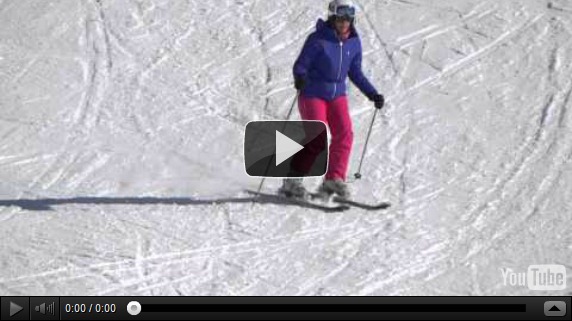Short Swings
Good progress was made yesterday but I’d noticed a postural issue that needed to be addressed for Sophie. This postural issue decided for me that the theme for the day should centre around relaxing the hip joints. Emily has for very good reasons not been the main centre of attention during the afternoons but I started the session with her and asking her to jump. The best way to jump most of the time is to fully extend the legs in the air and then bend to soften the landing. This guarantees a clean movement of the centre of mass upwards. Most people initially jump by mainly retracting the heels and failing to move the centre of mass. Any exercise that moves the centre of mass and uses the full range of motion of the legs is going to be useful. Emily already knew how to swing the skis into a turn from a pivot with the skis on the ground – sideslipping the fronts of the skis into the turn. Without realising it her playful practice at 360° spinning was also helping to develop this skill. The use of the adductors (“leg muscles” – as we called them in the session) also works for swinging the outside ski into the turn and enhancing the correct coordination. The upshot of all of this was that Emily’s first ever attempt at short swings (rhythmic jump turns) was surprisingly good – especially as she had no use of her poles for support – not having yet been taught how to use poles for short pivoted turns. The main point of this exercise was to make Emily bend and relax at the hip joints – sinking down through each turn so that she would be able to jump back up at the very end of the turn. This leads to a natural flexing and relaxation around the hips and permits a greater degree of dynamics while allowing the upper body to become more independent from the legs and rotate less in the turns. A skier’s development centre’s principally around increasing their dynamic range.
Pelvic Tilt
For Sophie we worked on pelvic tilt so as to achieve “neutral pelvis” and a slight contraction of the lower abdomen. To do this the hips need to be flexed to start with and after the pelvis is pulled up at the front the hips need to be relaxed again to ensure they are kept independent from the pelvis and not locked up. This spontaneously changed the arm carriage the first time Sophie did it, correcting it by bringing the elbows out to a normal position. In the photos below the arm carriage can be seen to be normal. The aim of “pelvic tilt” is to prevent the lower back from hollowing and so to protect the whole back – also integrating the upper and lower body correctly. When skiing Sophie had to remember to maintain pelvic tilt and to pull the hip back during the turn – quite a lot to handle really. Some people would really struggle to feel and sustain those things but Sophie has good body awareness and was able to achieve this with relative ease. The net result of all this concentration on everything from the feet to the overall dynamics in and out of the turn – and the flat ski glide between turns – was that her turns on steeper terrain were even more secure and skiing was not tiring her out. Emily’s first attempts at Short Swings – displaying good coordination and range of movement. Sophie is now much more symmetrical turning in left and right turns – with the severe right hip rotation now under control. Through the last half of the turn – before coming up to complete the turn – there is some more flexibility in the hip which allows pressure and directional control to build up with the body being held more securely inside the turn.
Sophie is skiing much faster, more securely and without any difficulty on steeper sections. There is still the glitch during turn transitions but it’s more of left over artefact now than an indication of fundamental problems. It’s impossible to focus on all the changes that Sophie is making and also completely avoid every additional unconscious act. Practice is obviously necessary to consolidate all the different parts and then the overall picture would tidy up dramatically.
When I’m not watching Emily and asking her to focus she has a tendency to fall over during just about every single run. I suspect that it’s because when she is not focused on dynamics she stands on her inside leg for support – as she always falls into the hill. This is most likely coming from other things that she is picking up elsewhere because there is no sign of the problem when specifically applying correct instructions.
The moon looks surreal in daylight…
…an hour later…

